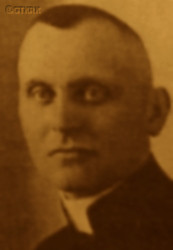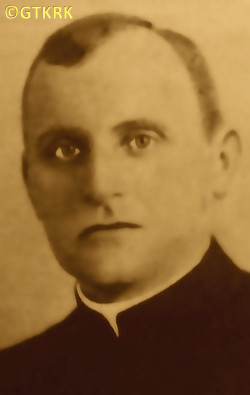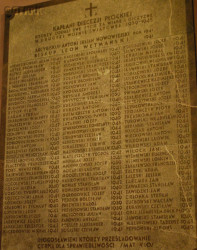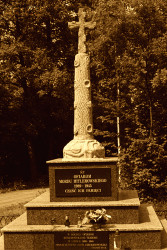Roman Catholic
St Sigismund parish
05-507 Słomczyn
85 Wiślana Str.
Konstancin deanery
Warsaw archdiocese, Poland
full list:
displayClick to display full list

searchClick to search full list by categories
wyświetlKliknij by wyświetlić pełną listę po polsku

szukajKliknij by przeszukać listę wg kategorii po polsku

Martyrology of the clergy — Poland
XX century (1914 – 1989)
personal data
surname
KARWOWSKI
forename(s)
John (pl. Jan)
function
diocesan priest
creed
Latin (Roman Catholic) Church RCmore on
en.wikipedia.org
[access: 2014.09.21]
diocese / province
Płock diocesemore on
en.wikipedia.org
[access: 2013.05.19]
academic distinctions
Bachelor of Dogmatic Theology
honorary titles
honorary canonmore on
en.wikipedia.org
[access: 2014.11.14]
(25.11.1938, Annunciation to the Blessed Virgin Mary RC collegiate church, Pułtusktoday: Pułtusk gm., Pułtusk pov., Masovia voiv., Poland
more on
en.wikipedia.org
[access: 2021.12.18])
Gold „Cross of Merit”more on
en.wikipedia.org
[access: 2019.04.16]
(03.12.1938)
date and place
of death
11.01.1940

Ościsłowotoday: Glinojeck gm., Ciechanów pov., Masovia voiv., Poland
more on
en.wikipedia.org
[access: 2021.12.18]
details of death
In mid–1939, fearing the outbreak of the war, secured the most valuable liturgical and church treasures as well as family treasures from the property of Duchess Mary Louise Joanne Josephine Czartoryska née Krasiński, in Krasne, and bricked them — in a metal coffin — in the basement of the parish church in Krasne (Duchess Czartoryska died in 1958 in exile, and the treasure was not found until 1992, after the end of the Russian occupation).
After German invasion of Poland on 01.09.1939 (Russians invaded Poland 17 days later) and start of the World War II joined the refuge crowd and went to Warsaw.
After Warsaw capitulation and start of German occupation returned in 10.1939 to his parish.
At the beginning of 11.1939 evicted by the Germans from his rectory and later on 08.11.1939 arrested.
Jailed in Ciechanów prison.
Released after two months, on 08.01.1940, returned to his parish.
There three day later on 11.01.1940 arrested by the Germans again, driven out together with Fr Stephen Nowakowski among others and on the same day executed (might have been held again in Ciechanów prior to murder) in a mass murder in Ościsłowo forest.
cause of death
mass murder
perpetrators
Germans
sites and events
OścisłowoClick to display the description, CiechanówClick to display the description, «Aktion T4»Click to display the description, «Intelligenzaktion»Click to display the description, Regierungsbezirk ZichenauClick to display the description, Ribbentrop‐MolotovClick to display the description, Pius XI's encyclicalsClick to display the description
date and place
of birth
25.06.1896Birth certification on:
metryki.genealodzy.pl
[access: 2025.03.16]

Sadkowotoday: Dzierzążnia gm., Płońsk pov., Masovia voiv., Poland
more on
en.wikipedia.org
[access: 2021.12.18]
parents
KARWOWSKI Joseph
🞲 ?, ? — 🕆 ?, ?

RZESZOTARSKA Felix
🞲 ?, ? — 🕆 ?, ?
baptism
28.06.1896Birth certification on:
metryki.genealodzy.pl
[access: 2025.03.16]

Skołatowotoday: Dzierzążnia gm., Płońsk pov., Masovia voiv., Poland
more on
en.wikipedia.org
[access: 2021.12.18]
St Acathius RC church
presbyter (holy orders)
ordination
27.10.1918

Płocktoday: Płock city pov., Masovia voiv., Poland
more on
en.wikipedia.org
[access: 2021.12.18]
RC chapelmore on
pl.wikipedia.org
[access: 2021.12.19] (in Theological Seminary)
positions held
1932 – 1940
parish priest — Krasnetoday: Krasne gm., Przasnysz pov., Masovia voiv., Poland
more on
en.wikipedia.org
[access: 2021.12.18] ⋄ Exaltation of the Holy Cross RC church ⋄ St John the Baptist RC parish ⋄ Maków Mazowieckitoday: Maków Mazowiecki urban gm., Maków Mazowiecki pov., Masovia voiv., Poland
more on
en.wikipedia.org
[access: 2021.08.06] RC deanery
1930 – 1932
director — Płocktoday: Płock city pov., Masovia voiv., Poland
more on
en.wikipedia.org
[access: 2021.12.18] ⋄ Catholic Action Institute, Diocesan Curia ⋄ Płock RC diocese — first director
1927 – 1930
prefect — Gostynintoday: Gostynin gm., Gostynin pov., Masovia voiv., Poland
more on
en.wikipedia.org
[access: 2021.12.18] ⋄ Thaddeus Kościuszko's State Philological Gymnasium and public elementary school ⋄ St Martin the Bishop and Confessor RC parish ⋄ Gostynintoday: Gostynin gm., Gostynin pov., Masovia voiv., Poland
more on
en.wikipedia.org
[access: 2021.12.18] RC deanery
1926 – 1927
prefect — Wymyślintoday: part of Skępe, Skępe gm., Lipno pov., Kuyavia‐Pomerania voiv., Poland
more on
en.wikipedia.org
[access: 2021.12.18] ⋄ Teachers' Seminary ⋄ Skępetoday: Skępe gm., Lipno pov., Kuyavia‐Pomerania voiv., Poland
more on
en.wikipedia.org
[access: 2021.12.18], Annunciation to the Blessed Virgin Mary RC parish ⋄ Sierpctoday: Sierpc urban gm., Sierpc pov., Masovia voiv., Poland
more on
en.wikipedia.org
[access: 2021.12.18] RC deanery
1919 – 1926
prefect — Pułtusktoday: Pułtusk gm., Pułtusk pov., Masovia voiv., Poland
more on
en.wikipedia.org
[access: 2021.12.18] ⋄ Klaudyna Potocka's Gymnasium for Girls and Teachers' Seminary ⋄ Annunciation to the Blessed Virgin Mary RC collegiate church ⋄ St Matthew the Apostle and the Evangelist RC parish ⋄ Pułtusktoday: Pułtusk gm., Pułtusk pov., Masovia voiv., Poland
more on
en.wikipedia.org
[access: 2021.12.18] RC deanery
1918 – 1919
vicar — Góratoday: Staroźreby gm., Płock pov., Masovia voiv., Poland
more on
en.wikipedia.org
[access: 2021.07.18] ⋄ St James the Apostle RC parish ⋄ Płońsktoday: Płońsk urban gm., Płońsk pov., Masovia voiv., Poland
more on
en.wikipedia.org
[access: 2021.12.18] RC deanery
1914 – 1918
student — Płocktoday: Płock city pov., Masovia voiv., Poland
more on
en.wikipedia.org
[access: 2021.12.18] ⋄ philosophy and theology, Theological Seminary
others related
in death
NOWAKOWSKIClick to display biography Steven
sites and events
descriptions
Ościsłowo: In 01.1940‐02.1940 Germans murdered in Ościsłowo forests n. Glinojeck in excess of 1,700 Poles, mainly sick and disabled and intelligentsia — as part of «Intelligenzaktion», extermination of Polish intelligentsia — from Ciechanów county and jailed in Ciechanów prison. The murders took place also in the following years. In the largest mass murder in Germ. Regierungsbezirk Zichenau (Eng. Ciechanów Regency), part of German province Germ. Ostpreußen (Eng. East Prussia), in German occupied northern Masovia where German state law was in force, Germans murdered on 20.02.1940 c. 900 disabled (some sources talk about 2,000‐3,000 victims). Among the victims of Ościsłowo forest were at least two Catholic priests. (more on: www.ciechtivi.plClick to attempt to display webpage
[access: 2013.12.04])
Ciechanów: Detention centre run by Germans. After German expulsion by the Russians in 1945 also a Russian transit camp for German prisoners, among others, prior to exile to concentration camps in Russia. (more on: pl.wikipedia.orgClick to attempt to display webpage
[access: 2013.12.04])
«Aktion T4»: German state euthanasia program, systematic murder of people mentally retarded, chronically, mentally and neurologically ill — „elimination of live not worth living” (Germ. „Vernichtung von lebensunwertem Leben”). At a peak, in 1940‐1941, c. 70,000 people were murdered, including patients of psychiatric hospitals in German occupied Poland — German formalists noted then that, among others, „performing disinfection [i.e. gassing] of 70,273 people with a life expectancy of up to 10 years saved food in the amount of 141,775,573.80 Deutschmark”. From 04.1941 also mentally ill and „disabled” (i.e. unable to work) prisoners held in German concentration camps were included in the program — denoted then as «Aktion 14 f 13». C. 20,000 inmates were then murdered, including Polish Catholic priests held in KL Dachau concentration camp, who were murdered in Hartheim gas chambers. The other „regional extension” of «Aktion T4» was «Aktion Brandt» program during which Germans murdered chronically ill patients in order to make space for wounded soldiers. It is estimated that at least 30,000 were murdered in this program. (more on: en.wikipedia.orgClick to attempt to display webpage
[access: 2014.10.31])
«Intelligenzaktion»: German: «Intelligenzaktion» (English: „Intelligence Action”) — a German program of extermination of the Polish elite, mainly the intelligentsia and leadership layers, carried out from the beginning of the occupation in w 09.1939 to 04.1940, mainly in territories directly annexed to Germany, but also in the so‐called Germ. Generalgouvernement (Eng. General Governorate), where it was called «AB‐aktion». In the first phase, immediately after the beginning of the German occupation, during military operations carried out by the Germ. Wehrmacht (Eng. Armed Forces) and the genocidal units of the Germ. Einsatzgruppen (Eng. Operational Groups) of the Germ. Sicherheitspolizei (Eng. Security Police), i.e. SiPo, and Germ. Sicherheitsdienst des Reichsführers SS (Eng. Security Service of the Reichsführer SS), i.e. SD, organized by the Germ. Reichssicherheitshauptamt (Eng. Reich Main Security Office), i.e. RSHA, which followed the troops, carried out under the Germ. Unternehmen „Tannenberg” (Eng. Operation „Tannenberg”) — based on the so‐called Germ. Sonderfahndungsliste (Eng. Special Wanted Lists), i.e. proscription lists of Poles considered particularly dangerous to the Third Reich, prepared by the Zentralstelle II/P (Polen) unit of the German RSHA. Later, implemented by the German civilian occupation authorities and the genocidal unit of the Germ. Volksdeutscher Selbstschutz (Eng. Ethnic Germans Self‐Defense), whose members were Germ. Volksdeutsche (Eng. Ethnic Germans), i.e. representatives of the German minority in Poland. According to various sources, these lists, at the beginning of 09.1939, could have contained the details of 61,000—88,000 „dangerous” Poles — although these figures cannot be confirmed. In total, during this genocide, c. 50,000 teachers, Catholic priests, representatives of the landed gentry, freelancers, social and political activists, and retired military personnel were systematically and methodically murdered. Another 50,000 were sent to concentration camps, where only a negligible percentage survived. (more on: en.wikipedia.orgClick to attempt to display webpage
[access: 2014.10.04])
Regierungsbezirk Zichenau: After the Polish defeat in the 09.1939 campaign, which was the result of the Ribbentrop‐Molotov Pact and constituted the first stage of World War II, and the beginning of German occupation in part of Poland (in the other, eastern part of Poland, the Russian occupation began), the Germans divided the occupied Polish territory into five main regions (and a few smaller). The largest one was transformed into Germ. Generalgouvernement (Eng. General Governorate), intended exclusively for Poles and Jews and constituting part of the so‐called Germ. Großdeutschland (Eng. Greater Germany). From two separate new provinces were created. The two remaining were incorporated into existing German provinces. One of those was the Germ. Regierungsbezirk Zichenau (Eng. Ciechanów regency), created from part of the occupied Warsaw voivodeship, and incorporated into the Germ. Provinz Ostpreußen (Eng. East Prussia) — on the basis of the decree of the German leader Adolf Hitler of 08.10.1939 (formally in force from 26.10.1939) — in which the law of the German state was applicable. The main axis of the policy of the new regency, the territory of which the Germans recognized as the Germ. „Ursprünglich Deutsche” (Eng. „natively German”), despite the fact only 6% of its pre–war Polish part were Germans, was Germ. „Entpolonisierung” (Eng. „Depolonisation”), i.e. forced Germanization, and Germ. Zwangsarbeit (Eng. forced slave labor). Most of the Germ. Zivilarbeiter (Eng. civilian worker) slaved in the Germ. Provinz Ostpreußen. Some Poles— c. 25,000 — were deported to the Germ. Generalgouvernement; some were sent to concentration camps. Children could only learn in German. A policy of terror was pursued against the Polish population — 8 large prisons operated in a small area, Polish organizations and institutions were closed. The Polish press was liquidated. Of the 200 arrested Catholic priests from the Płock diocese, 110 were murdered. Most parishes were left without pastors — only a few priests per county were allowed to serve. Conducting services, sermons and confessions in Polish was prohibited. Churches were plundered and turned into warehouses. Catholic funerals with more than 10 people were prohibited. Crosses, roadside shrines, tombstones and cemeteries were destroyed. After the end of hostilities of World War II, the overseer of this province, the Germ. Reichsstatthalter (Eng. Reich Governor) and the Germ. Gauleiter (Eng. district head) of the German National Socialist Party, Erich Koch, initially went into hiding, then was captured and extradited to the Commie–Nazi republic of Poland prl, sentenced to death, but the sentence was not carried out and died in prison in 1986. The Germ. Regierungspräsidenten Zichenau (Eng. superpresident of the Ciechanów regency) hid better and his post‐war fate is still unknown. (more on: en.wikipedia.orgClick to attempt to display webpage
[access: 2024.06.24])
Ribbentrop‐Molotov: Genocidal Russian‐German alliance pact between Russian leader Joseph Stalin and German leader Adolf Hitler signed on 23.08.1939 in Moscow by respective foreign ministers, Mr. Vyacheslav Molotov for Russia and Joachim von Ribbentrop for Germany. The pact sanctioned and was the direct cause of joint Russian and German invasion of Poland and the outbreak of the World War II in 09.1939. In a political sense, the pact was an attempt to restore the status quo ante before 1914, with one exception, namely the „commercial” exchange of the so‐called „Kingdom of Poland”, which in 1914 was part of the Russian Empire, fore Eastern Galicia (today's western Ukraine), in 1914 belonging to the Austro‐Hungarian Empire. Galicia, including Lviv, was to be taken over by the Russians, the „Kingdom of Poland” — under the name of the General Governorate — Germany. The resultant „war was one of the greatest calamities and dramas of humanity in history, for two atheistic and anti‐Christian ideologies — national and international socialism — rejected God and His fifth Decalogue commandment: Thou shall not kill!” (Abp Stanislav Gądecki, 01.09.2019). The decisions taken — backed up by the betrayal of the formal allies of Poland, France and Germany, which on 12.09.1939, at a joint conference in Abbeville, decided not to provide aid to attacked Poland and not to take military action against Germany (a clear breach of treaty obligations with Poland) — were on 28.09.1939 slightly altered and made more precise when a treaty on „German‐Russian boundaries and friendship” was agreed by the same murderous signatories. One of its findings was establishment of spheres of influence in Central and Eastern Europe and in consequence IV partition of Poland. In one of its secret annexes agreed, that: „the Signatories will not tolerate on its respective territories any Polish propaganda that affects the territory of the other Side. On their respective territories they will suppress all such propaganda and inform each other of the measures taken to accomplish it”. The agreements resulted in a series of meeting between two genocidal organization representing both sides — German Gestapo and Russian NKVD when coordination of efforts to exterminate Polish intelligentsia and Polish leading classes (in Germany called «Intelligenzaktion», in Russia took the form of Katyń massacres) where discussed. Resulted in deaths of hundreds of thousands of Polish intelligentsia, including thousands of priests presented here, and tens of millions of ordinary people,. The results of this Russian‐German pact lasted till 1989 and are still in evidence even today. (more on: en.wikipedia.orgClick to attempt to display webpage
[access: 2015.09.30])
Pius XI's encyclicals: Facing the creation of two totalitarian systems in Europe, which seemed to compete with each other, though there were more similarities than contradictions between them, Pope Pius XI issued in 03.1937 (within 5 days) two encyclicals. In the „Mit brennender Sorge” (Eng. „With Burning Concern”) published on 14.03.1938, condemned the national socialism prevailing in Germany. The Pope wrote: „Whoever, following the old Germanic‐pre‐Christian beliefs, puts various impersonal fate in the place of a personal God, denies the wisdom of God and Providence […], whoever exalts earthly values: race or nation, or state, or state system, representatives of state power or other fundamental values of human society, […] and makes them the highest standard of all values, including religious ones, and idolizes them, this one […] is far from true faith in God and from a worldview corresponding to such faith”. On 19.03.1937, published „Divini Redemptoris” (Eng. „Divine Redeemer”), in which criticized Russian communism, dialectical materialism and the class struggle theory. The Pope wrote: „Communism deprives man of freedom, and therefore the spiritual basis of all life norms. It deprives the human person of all his dignity and any moral support with which he could resist the onslaught of blind passions […] This is the new gospel that Bolshevik and godless communism preaches as a message of salvation and redemption of humanity”… Pius XI demanded that the established human law be subjected to the natural law of God , recommended the implementation of the ideal of a Christian state and society, and called on Catholics to resist. Two years later, National Socialist Germany and Communist Russia came together and started World War II. (more on: www.vatican.vaClick to attempt to display webpage
[access: 2023.05.28], www.vatican.vaClick to attempt to display webpage
[access: 2023.05.28])
sources
personal:
mazowsze.hist.plClick to attempt to display webpage
[access: 2013.01.13], pamiec.plClick to attempt to display webpage
[access: 2014.01.16], metryki.genealodzy.plClick to attempt to display webpage
[access: 2025.03.16], osp.wezewo.infoClick to attempt to display webpage
[access: 2021.12.18]
bibliographical:
„Płock diocese clergy martyrology during II World War 1939‐1945”, Fr Nicholas Marian Grzybowski, Włocławek–Płock 2002
„Martyrology of the Polish Roman Catholic clergy under nazi occupation in 1939‐1945”, Victor Jacewicz, John Woś, vol. I‐V, Warsaw Theological Academy, 1977‐1981
original images:
osp.wezewo.infoClick to attempt to display webpage
[access: 2021.12.18], glinojeck.infoClick to attempt to display webpage
[access: 2015.05.09]
LETTER to CUSTODIAN/ADMINISTRATOR
If you have an Email client on your communicator/computer — such as Mozilla Thunderbird, Windows Mail or Microsoft Outlook, described at WikipediaPatrz:
en.wikipedia.org, among others — try the link below, please:
LETTER to CUSTODIAN/ADMINISTRATORClick and try to call your own Email client
If however you do not run such a client or the above link is not active please send an email to the Custodian/Administrator using your account — in your customary email/correspondence engine — at the following address:

giving the following as the subject:
MARTYROLOGY: KARWOWSKI John
To return to the biography press below:
 Click to return to biography
Click to return to biography











